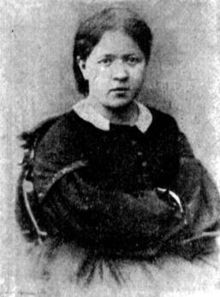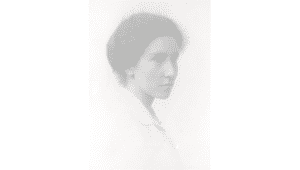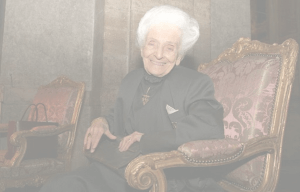This year’s International Day of Girls and Women in Science (11F) is as good as any to spark a conversation about the discoveries of female researchers which, despite having profoundly influenced our understanding of the world, have been overlooked, ignored, or discredited. Coinciding with Maria Manasseina’s 180th Anniversary, here is an untold story of her ground-breaking contributions to two completely disparate fields.

Some of you may have previously come across the saying that sleep is more vital to us than food. This statement is based on the investigations about sleep carried out by Dr Marie de Manacéine (1843-1903), or Maria Mikhailovna Manasseina in her native Russian. During her time in Ivan Tarkhanov’s laboratory, she empirically investigated the bodily changes caused by lack of sleep in a study that would, rightfully, never be approved by a contemporary ethical evaluation. In this study, a chronic sleep deprivation protocol was found to cause animal death within five days. This was in stark contrast to the 20-25 days of starvation required for the same fatal consequence.
This study took place at a time in which the use and misuse of animals in research was unfortunately widespread. Since then, abundant progress has been made to ensure that studies involving animals are strictly evaluated and carefully monitored. Nowadays, animal research is assessed by ethical committees which, among several other considerations, ensure the three Rs: replacing animals with other means whenever possible, reducing the number of animals and refining the experimental procedures so as to minimise animal pain, suffering, distress, or lasting harm.
Maria Manasseina’s investigation was the first to unveil the bodily changes caused by lack of sleep: the animals’ body temperature decreased by 4-6°C degrees, suggesting that the homeostatic control of the body was altered; the number of red blood cells was substantially reduced, indicative of damage to the immune system; and the brain was plagued by injuries such as local haemorrhages, impaired blood vessels and damage to the fat (myelin) that supports communication between neurons. Importantly, understanding the consequences of lack of sleep has been instrumental to developing treatments for sleep disorders.
Until Maria Manasseina’s discovery, the nervous system was not considered to be a key organ for sleep. However, her description of the bodily changes caused by lack of sleep localised, for the first time, most of the damage to the brain. Nowadays, sleep is decidedly investigated from the perspective of neuroscience and the nervous circuits mediating sleep are increasingly understood. Moreover, the study showed that older animals were less affected by lack of sleep longer than younger ones. This finding hinted at the link between sleep and development, whose importance has been increasingly acknowledged over the last decades.
Beyond her empirical results, Maria’s interpretations of her findings were instrumental to advancing the field of sleep research. She proposed that sleep in the brain is not a mere lack of neural activity but might instead be characterised by different kinds of neural activity than those observed during wakefulness. Indeed, her insight that the brain remains active while an organism is asleep was empirically confirmed in 1929 by Hans Berger’s electroencephalography recordings, which found abundant electrical activity in the sleeping brain. In fact, the differences in neural activity between sleep and wakefulness and within sleep itself have resulted in the classification of sleep into the stages known to us today. For example, Rapid Eye Movement (REM) sleep is characterised not only by the presence of eye movements, but also by specific patterns of electrical brain activity, which have been linked to dreaming. Similarly, slow fluctuations in brain activity are the hallmark of the “deepest” stage of sleep (N3) and they have been suggested to contribute to the restorative and homeostatic function of sleep. Consequently, Maria’s hypothesis that the brain may be active during sleep has been confirmed, and the role of these activity patterns in the functions subserved by sleep are an active area of current research.
Impressively, Maria’s scientific contributions were not restricted to the field of sleep research but also extended to what was then called physiological chemistry and what we now know as biochemistry. During her time in Julius Wiesner’s Laboratory in Vienna, Maria Manasseina discovered that a specific component of the yeast, what she called the “unorganized enzyme”, was responsible for alcoholic fermentation. This ground-breaking discovery discarded Louis Pasteur’s physiological theory of fermentation, which stated that living yeasts were responsible for this process, and provided strong support for the alternative, chemical hypothesis, according to which specific molecules within yeasts would be in charge of alcoholic fermentation.
The paramount importance of Maria Manasseina’s discovery is further illustrated by the fact that the same discovery made by Eduard Buchner a few years later, led to him being awarded the Nobel Prize in Chemistry (1907). Crucially, Maria Manasseina’s findings were purposefully ignored by Buchner and fellow colleagues in the field, and similar to the work of several female researchers throughout history, Maria Manasseina was never acknowledged nor credited for her discoveries.
Maria was a pioneer not only in her scientific discoveries, but also in her deep understanding of the responsibility of researchers to share and communicate their findings with the wider society. She was a brilliant teacher and an outstanding science communicator. She was the author of the sleep “encyclopaedia” of the time (Physiology, Pathology, Hygiene and Psychology of Sleep, published in English in 1892). Moreover, she published specialised articles and conference abstracts, together with books for general audiences about topics ranging from education to art, psychology, and biochemistry. Nevertheless, during her lifetime and still today, her multidisciplinary work and wide-ranging activities have been undermined, leading to a conception of her as a “popular writer” instead of a researcher.
By Irene Echeverria Altuna (@irenetxeberria). PhD Candidate in Neuroscience at University of Oxford.
More information:
- Maria Mikhailovna Manasseina, written by Favero, M., Mele, S. and Metitieri, T. (2017). Source: WiNEu, European Women in Neuroscience, Untold stories: the Women Pioneers of Neuroscience in Europe. Available online here.
- Bentivoglio M., Grassi-Zucconi G. (1997).
- Kovalzon V.M. (2009).
- Lagnado (1992).
- Book: de Manacéïne M. (1897): Sleep: Its Physiology, Pathology, Hygiene and Psychology. London, Walter Scott. Not available online.
- Book: de Manacéïne M. (1894): Quelques observations expérimentales sur l’influence de l’insomnie absolue. Archives Italiennes de Biologie 21: 322–325. Not available online.
- Berger H (1929).






